1. Directory structure
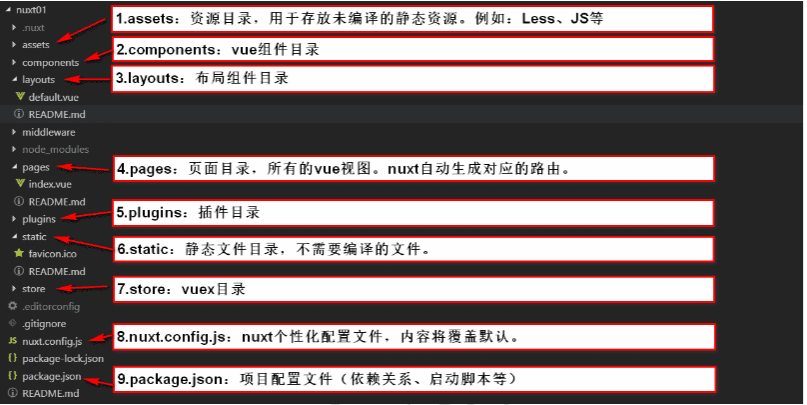
2. Aliases
- On the vue page of nuxt.js, you can use ~or ~~ if you need to import resources from a directory such as assets or static.

3. Routing
Nuxt.js automatically generates the routing configuration for the vue-router module based on the pages directory structure.
To use routing between pages, we recommend using the <nuxt-link>tag.
<router-link>is the label of vue's original ecological switch path.
<nuxt-link>On the basis of original ecology, nuxt enhancement is carried out.(Official example: https://zh.nuxtjs.org/examples/named-views/)
- Static Routing

- Dynamic Routing

- Dynamic Nested Routing

- Dynamic Route Naming

Does the path'/news/123'match'_id.vue' or'_name.vue'?
We can use <nuxt-link>to solve these problems
<nuxt-link:to="{name:'news-id',params:{id:1002}}">News 2</nuxt-link> <nuxt-link:to="{name:'news-name',params:{name:1003}}">News 3</nuxt-link>
Determine the component name by name: "xxx-yyy"
Pass value to corresponding parameter via params
- Default Route

4. Custom Layout
Create components in the layouts directory: layouts/blog.vue
Use blog layout in the view you want
<script> exportdefault{ layout:'blog' //... } </script>
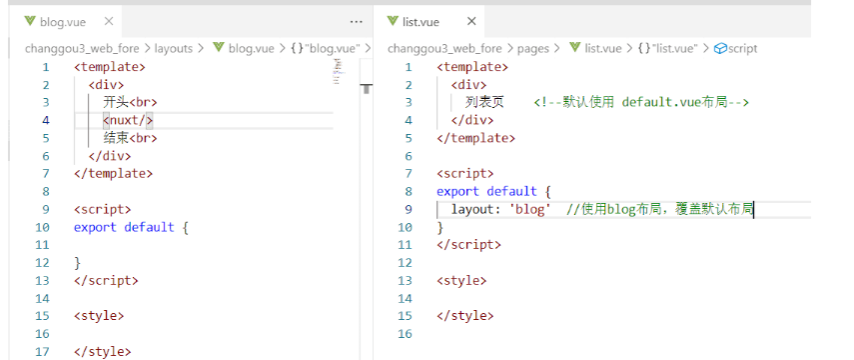
5. Error Page (write layouts/error.vue page to personalize error page)
<template> <divclass="container"> <h1v-if="error.statusCode===404">Page does not exist</h1> <h1v-else>Application Error Exception</h1> <nuxt-linkto="/">home page</nuxt-link> </div> </template> <script> exportdefault{ props:['error'], layout:'blog'//You can specify a custom layout for the error page } </script>
- Nuxt.js page (Page components are actually Vue components, but Nuxt.js adds some special configuration items to these components)

<template> <h1class="red">Hello{{name}}!</h1> </template> <script> exportdefault{ //Processing data asynchronously, called before each load asyncData(context){ //calledeverytimebeforeloadingthecomponent return{name:'World'} }, //State Tree (store) used to get data to populate the application before rendering the page fetch(){ //Thefetchmethodisusedtofillthestorebeforerenderingthepage }, //Configure Meta Tags for Current Page head(){ //SetMetaTagsforthisPage }, //andmorefunctionalitytodiscover ... } </script> <style> .red{ color:red; } </style> <template> <div> //Detail page {{$route.params.id}} <br/> <divclass="bg2"></div> <divclass="bg3"></div> </div> </template> <script> exportdefault{ head:{ title:'Detail Page', link:[ {rel:'stylesheet',href:'/style/img.css'} ], script:[ {type:'text/javascript',src:'/js/news.js'} ] } } </script> <style> .bg2{ background-image:url('~static/img/2.jpg'); width:300px; height:300px; background-size:300px; } </style>
6.nuxt Integration vuex
- Write only the core content of vuex in nuxt
Write:
//state area, equivalent to defining variables export const state = () => ({ }) //mutations area, used to modify data export const mutations = { //Method name (state, value) { } }
- state area note implementation:
//state area, equivalent to defining variables export const state = ()=> { return { } } //Omit Writing export const state = () => ({ })
- Case: 1) Create ~/store/index.js and write the following
//state area, equivalent to defining variables export const state = () => ({ pageInfo: '' }) //mutations area, used to modify data export const mutations = { setData( state , value) { state.pageInfo = value } }
Use
<script> import {mapState,mapMutation} from 'vuex' export default { //state area, combined with properties that need to be calculated computed: { ...mapState([variable,Variable 2,....]) }, //mutations area, modifying data, needs to be combined with methods methods: { ...mapMutation([Method Name,Method Name 2,....]) }, } </script>
2) Complete fetch operation
<template> <div> {{ this.$store.state.pageInfo }} </div> </template> <script> export default { async fetch( {$axios, store } ) { //Send ajax let { data } = await $axios.get('/userservice/user/list') console.info( data ) //Save query results in vuex store.commit('setData', data.data ) } } </script> <style> </style>
7. Integrating axios
- When you build a project, nuxt.js automatically integrates with axios if you choose the axios component.
- Integration effect:
1) package.json has axios version
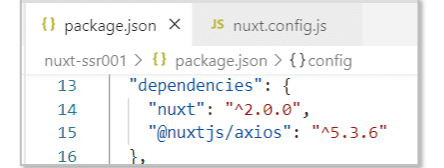
2) nuxt.config.js adds axios as a module
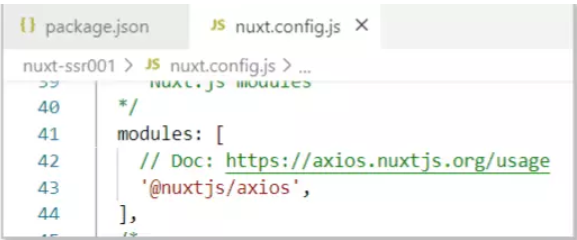
- Common configurations, modify nuxt.config.js to configure the baseURL
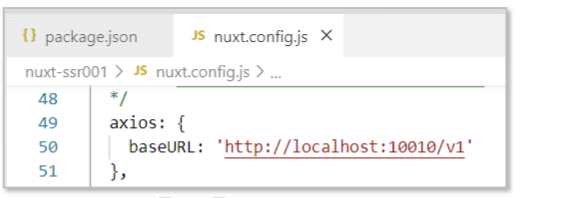
- Send ajax using Axios (in the vue page, manipulate ajax by this.$axios.xxx().this.$axios is equivalent to the previous axios.)
this.$axios.post("/search-service/search",this.searchMap).then(res=>{ //Get Query Results this.searchResult=res.data.data; });
- Send asynchronous data using asyncData (send an ajax to send an ajax request through content.$axios, equivalent to using Axios before).)
asyncasyncData(content){ let{data}=awaitcontent.$axios.get('/web-service/news',{ params:{ pageNum:1, pageSize:8, sortWay:'asc' } }) return{news:data.data} },
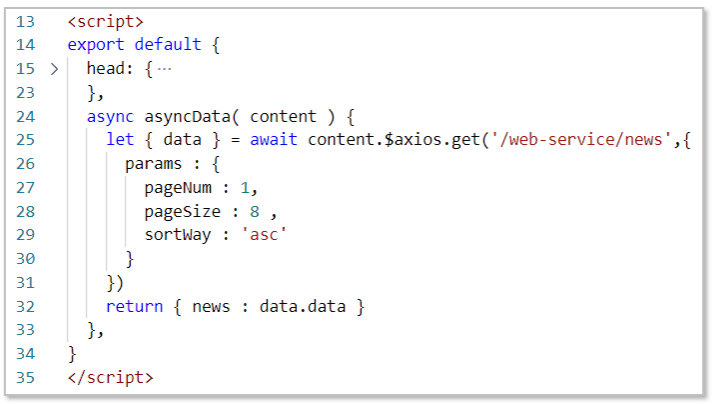
- Send multiple ajax
asyncasyncData(content){ let[Result 1,Result 2]=awaitPromise.all([ajax Request 1,ajax Request 2]) return{ topNews:Result 1 data, categorys:Data for Result 2 } },
asyncasyncData(content){ let[res,res2]=awaitPromise.all([ content.$axios.get("/web-service/news",{ params:{ pageNum:1, pageSize:8, sortWay:'asc' } }).then(res=>res), content.$axios.get("/web-service/categorys") .then(res=>res), ]) return{ topNews:res.data.data, categorys:res2.data.data } },
- Send ajax using fetch
<template> <div> //about </div> </template> <script> //import{test}from'~/plugins/api.js' import{mapState,mapMutations}from'vuex' exportdefault{ asyncfetch({store,$axios}){ let{data}=await$axios.get('/web-service/news',{ params:{ pageNum:1, pageSize:8, sortWay:'asc' } }) store.commit('setData',data.data) }, asyncmounted(){ let{data}=awaitthis.$axios.get('/web-service/news',{ params:{ pageNum:1, pageSize:8, sortWay:'asc' } }) localStorage.setItem('newssss',data.data.data) } } </script> <style> </style>
8. Plugins: Customize axios
- Step 1: Configure the plug-in
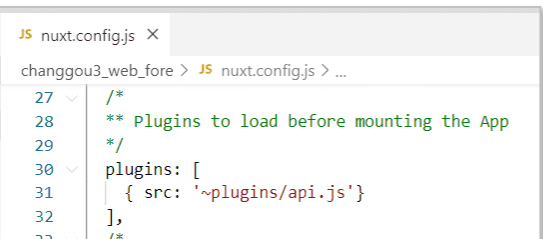
- Step 2: Write api.js to enhance the built-in $axios
//Custom Functions constrequest={ test:(params)=>{ returnaxios.get('/web-service/test',{ params }) }, } varaxios=null exportdefault({$axios},inject)=>{ //3) Save built-in axios axios=$axios //4) Submit custom functions to nuxt //Usage 1: In vue, this.$request.xxx() //Usage 2: In nuxt's asyncData, content.app.$request.xxx() inject('request',request) }
9.Vuex State Tree
- Each.js file in the store directory is converted to a named submodule specified in the state tree.index is the root module
1). Root module data operations
- Step 1: Modify store/index.js to add a counter variable and continue the cumulative operation
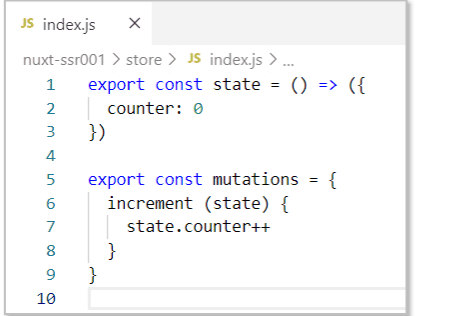
exportconststate=()=>({ counter:0 }) exportconstmutations={ increment(state){ state.counter++ } }
- Step 2: On the page, use
<template> <div> //Home page {{counter}} <inputtype="button"value="+"@click="increment"/> </div> </template> <script> import{mapState,mapMutations}from'vuex' exportdefault{ computed:{ ...mapState(['counter']) }, methods:{ ...mapMutations(['increment']) }, } </script> <style> </style>
2). Data operations for other modules
- Step 1: Create additional modules

exportconststate=()=>({ money:0 }) exportconstmutations={ addmoney(state){ state.money+=5 } }
- Step 2: Use the data in the specified module
<template> <div> //Home page {{money}} <inputtype="button"value="+"@click="addmoney"/> </div> </template> <script> import{mapState,mapMutations}from'vuex' exportdefault{ computed:{ money(){ returnthis.$store.state.book.money } }, methods:{ ...mapMutations({ addmoney:'book/addmoney' }) }, } </script> <style> </style>